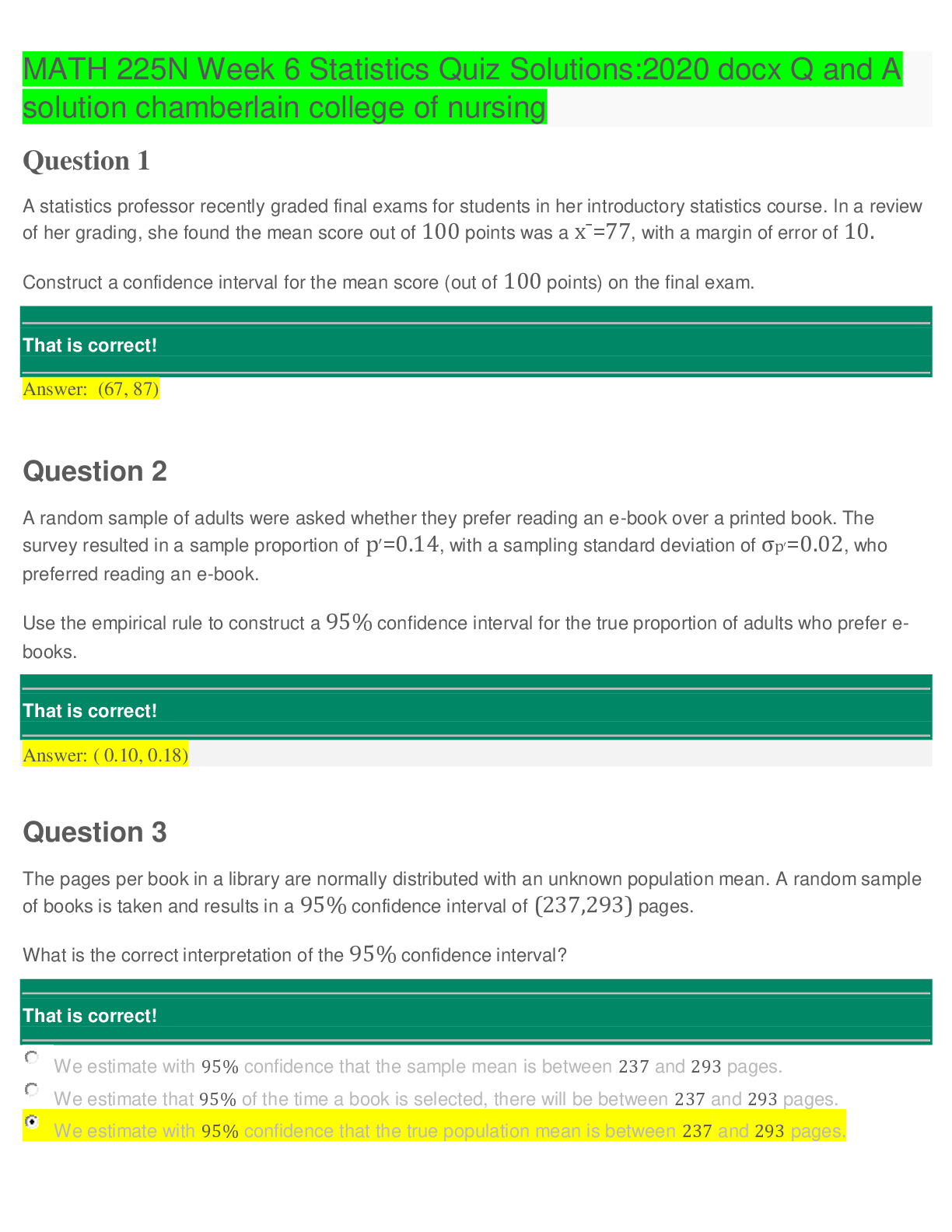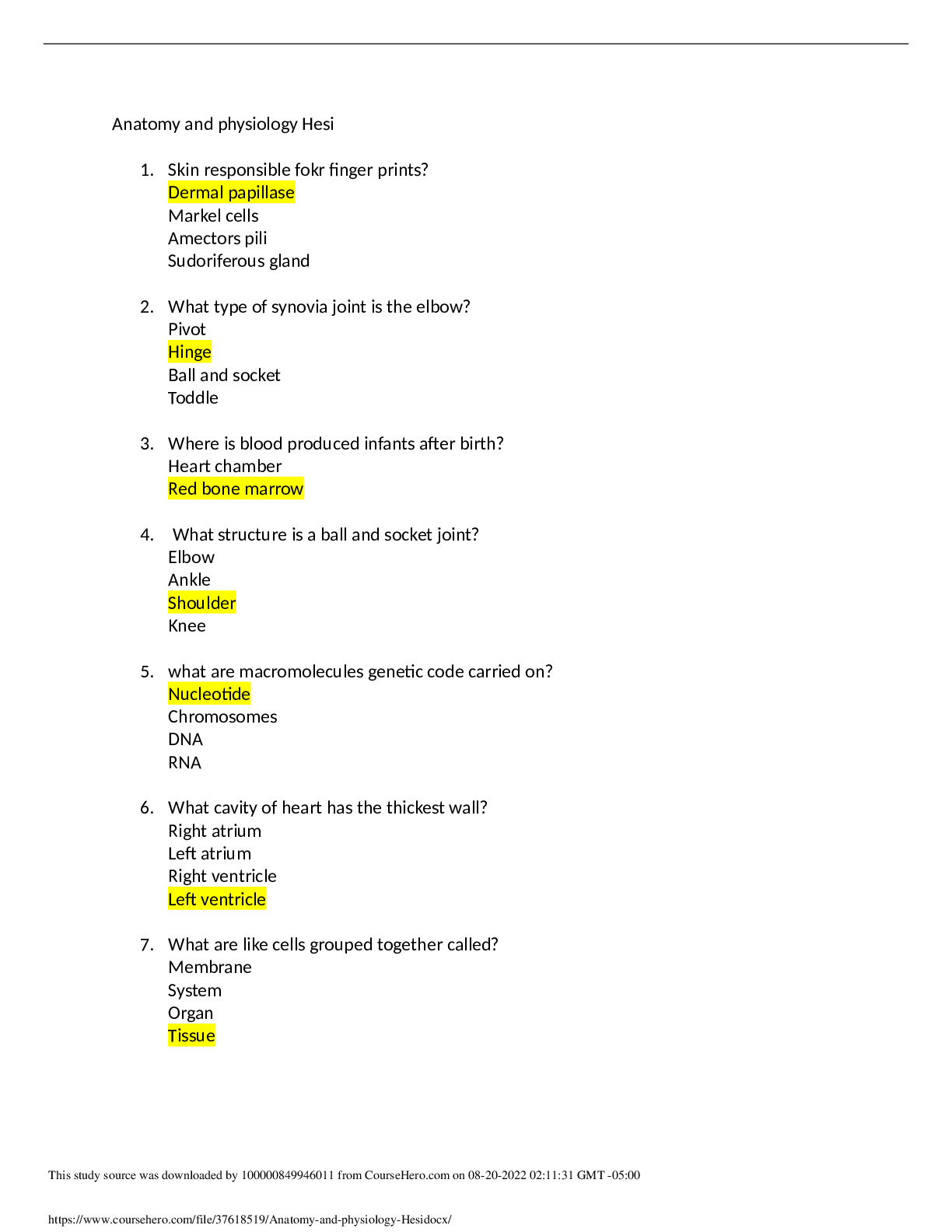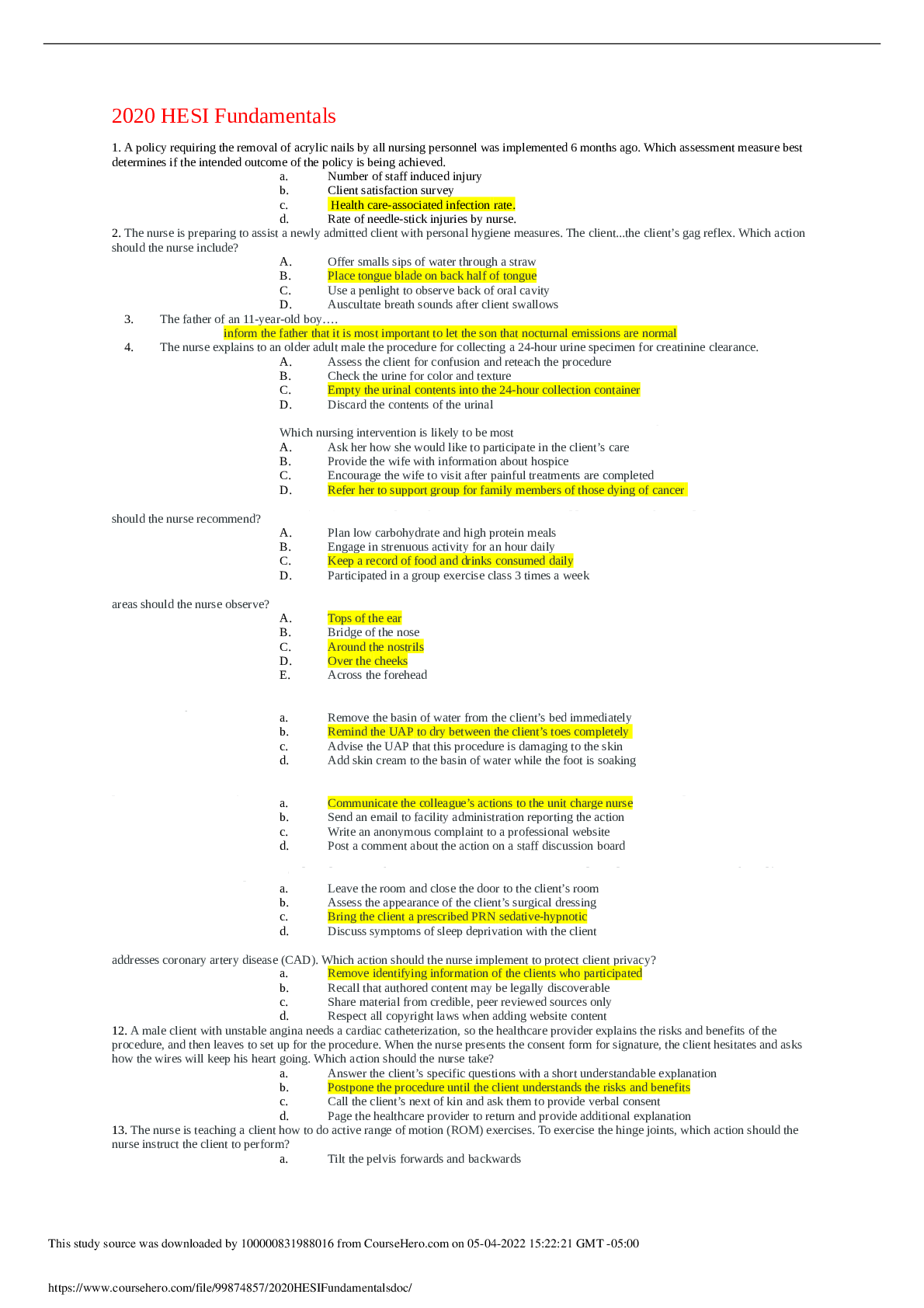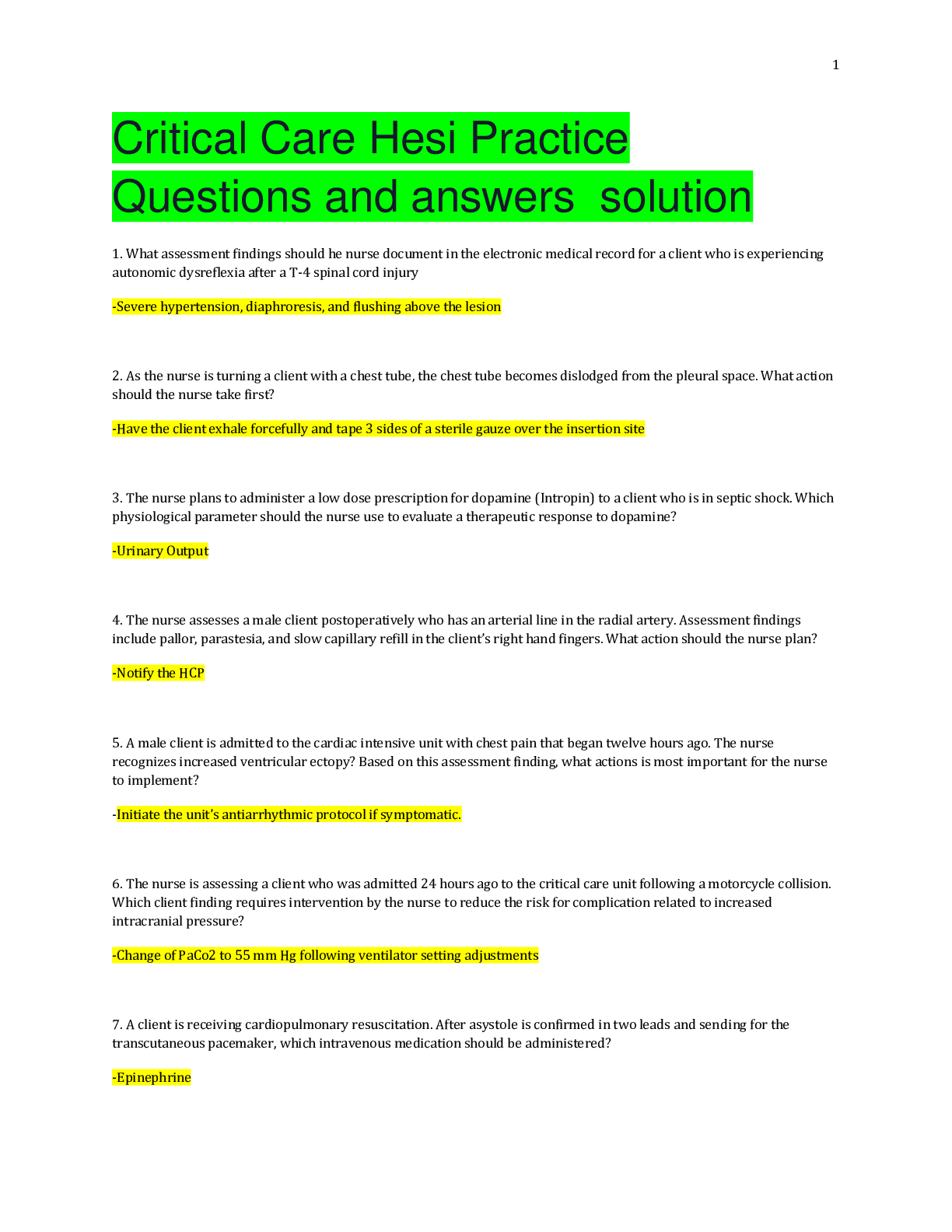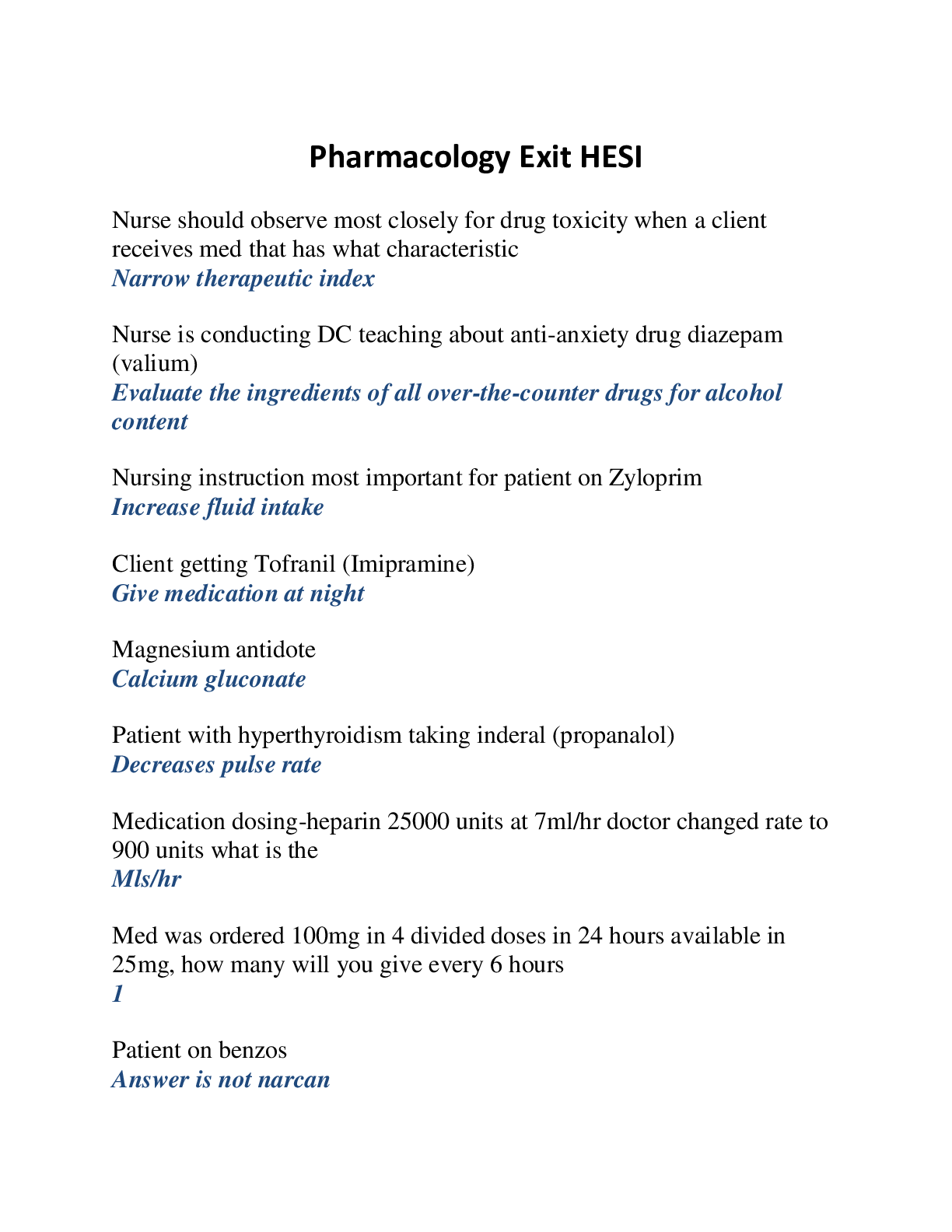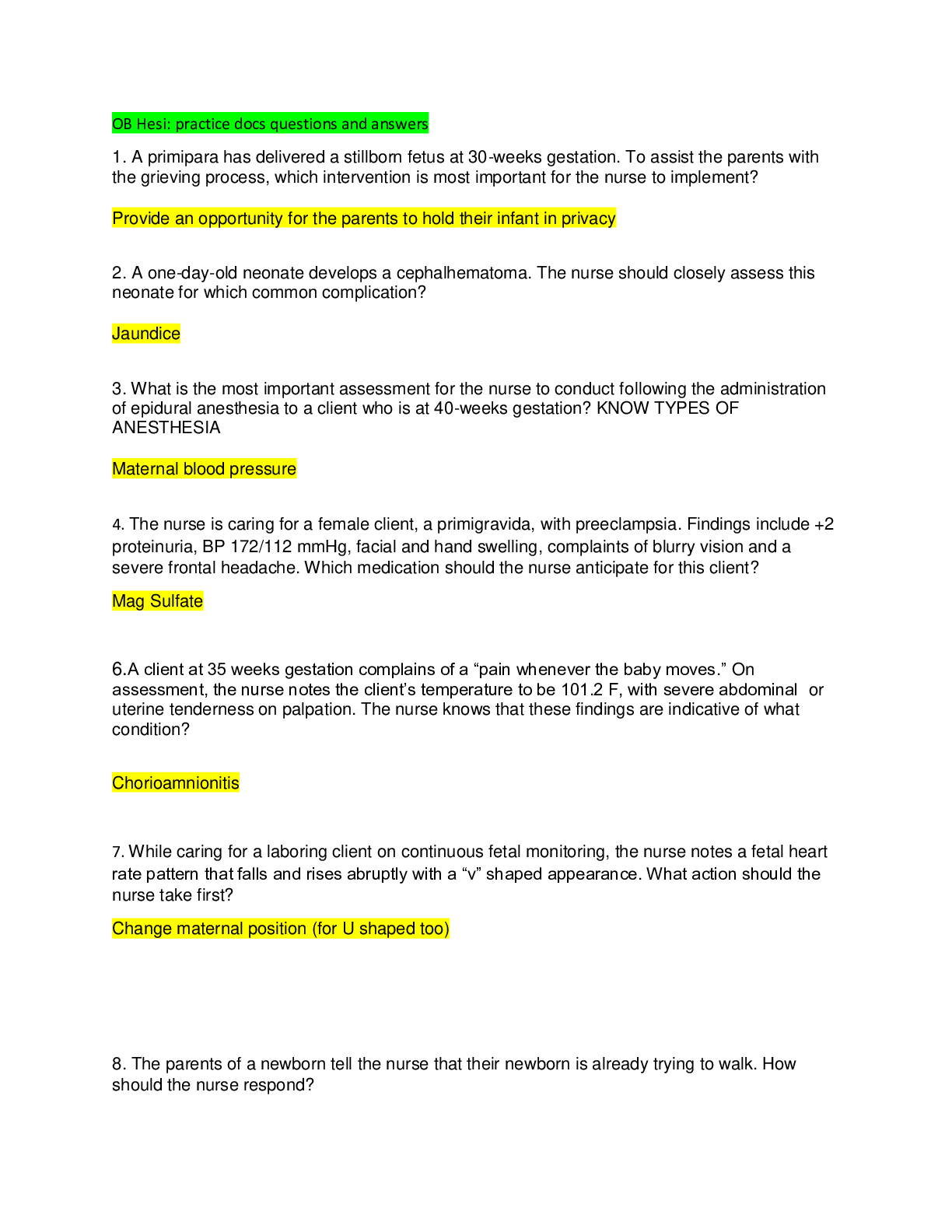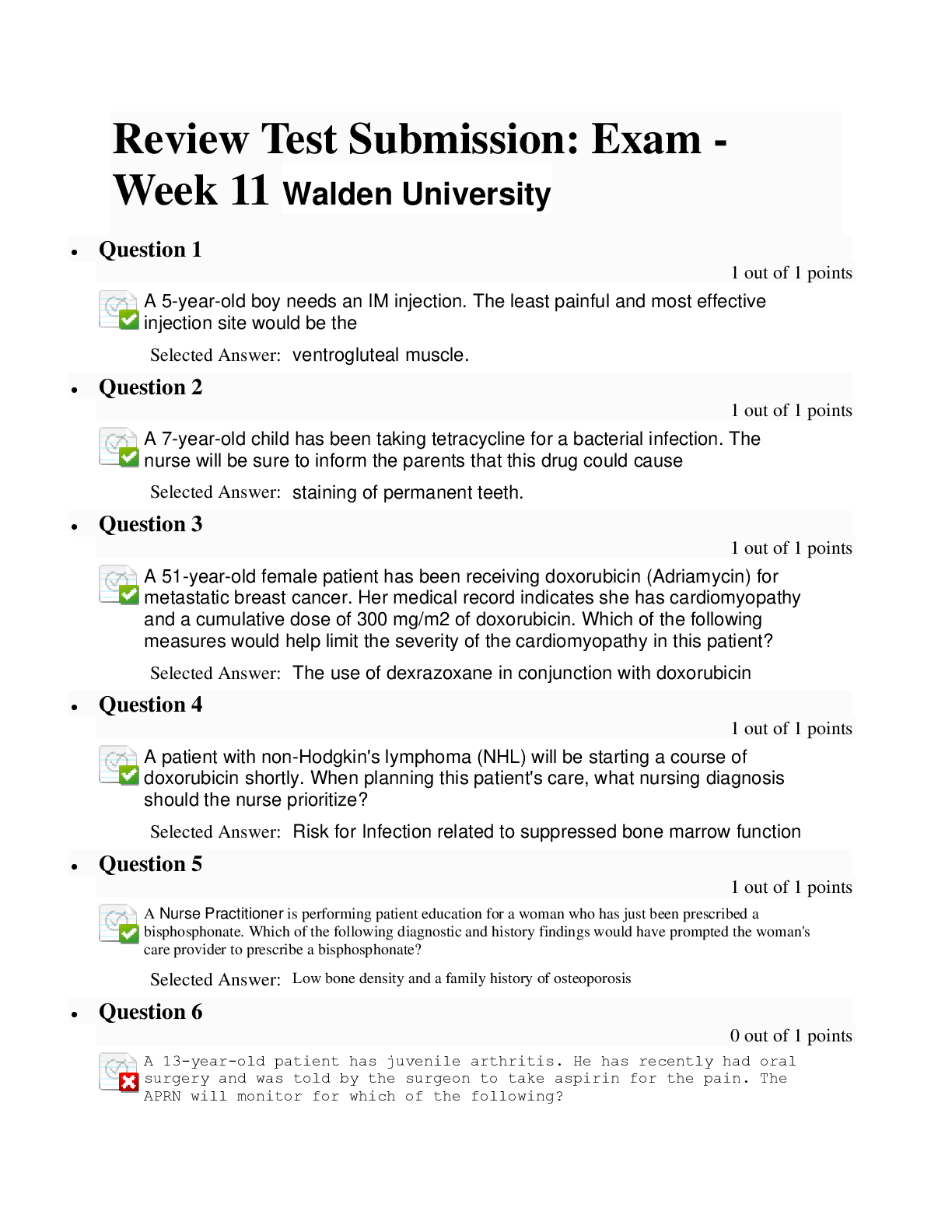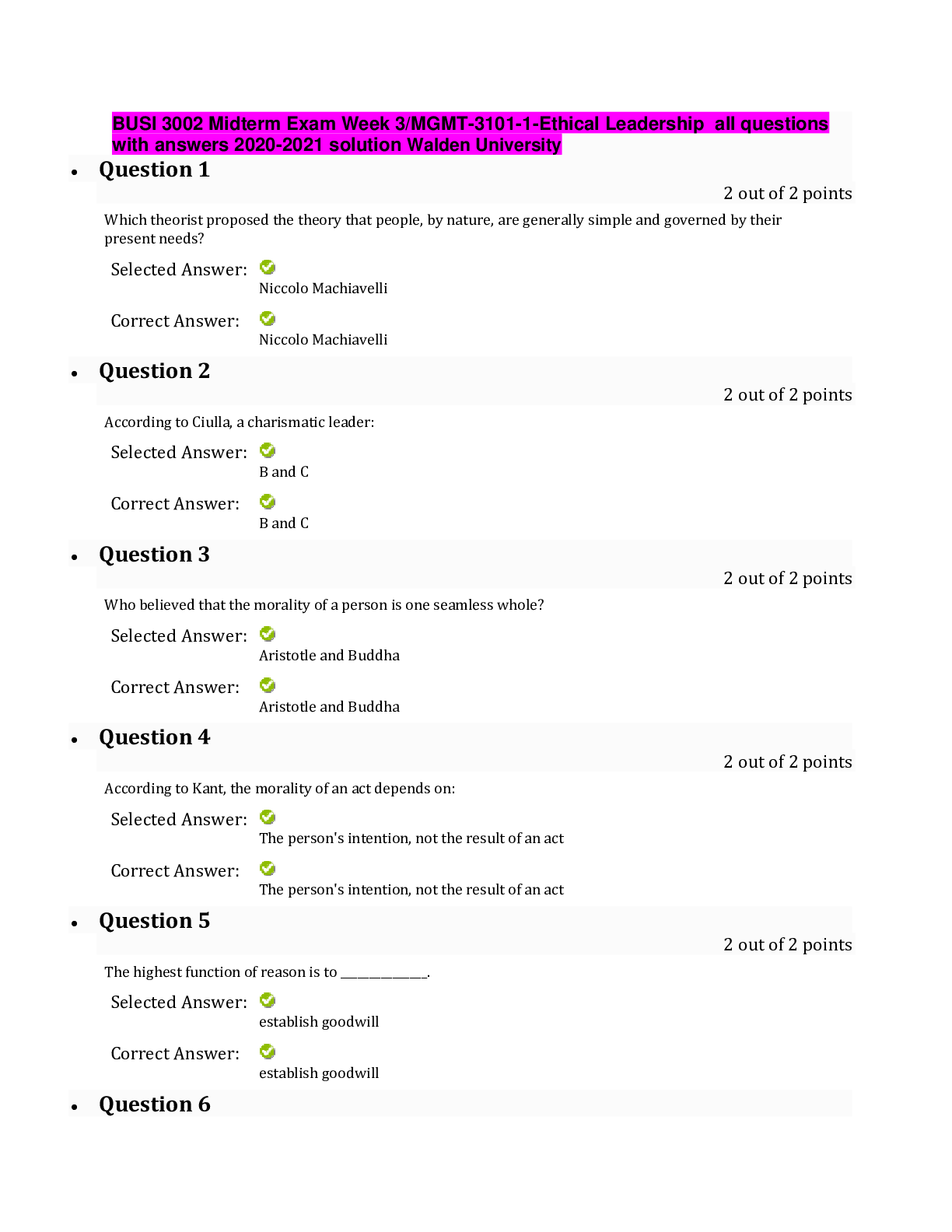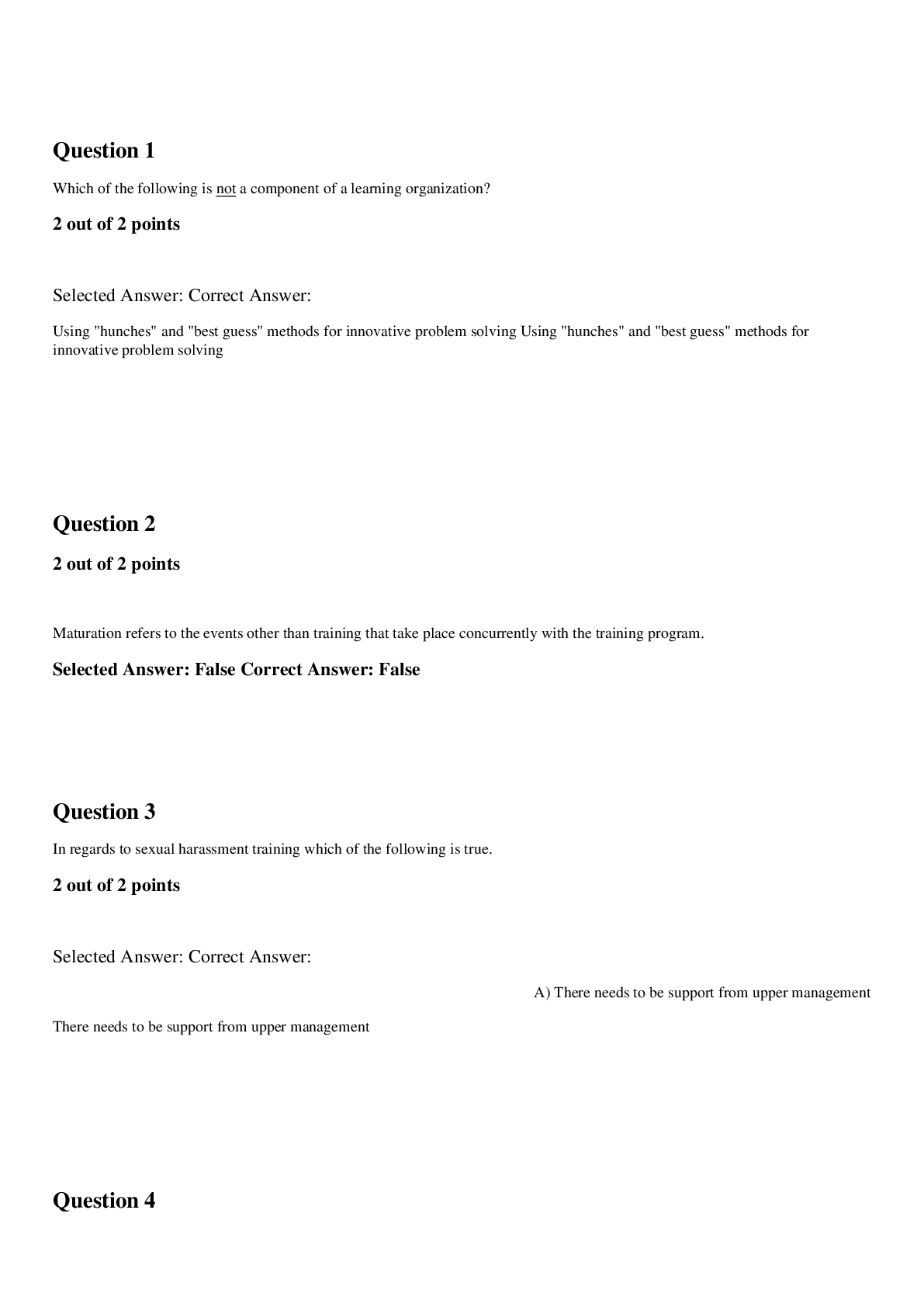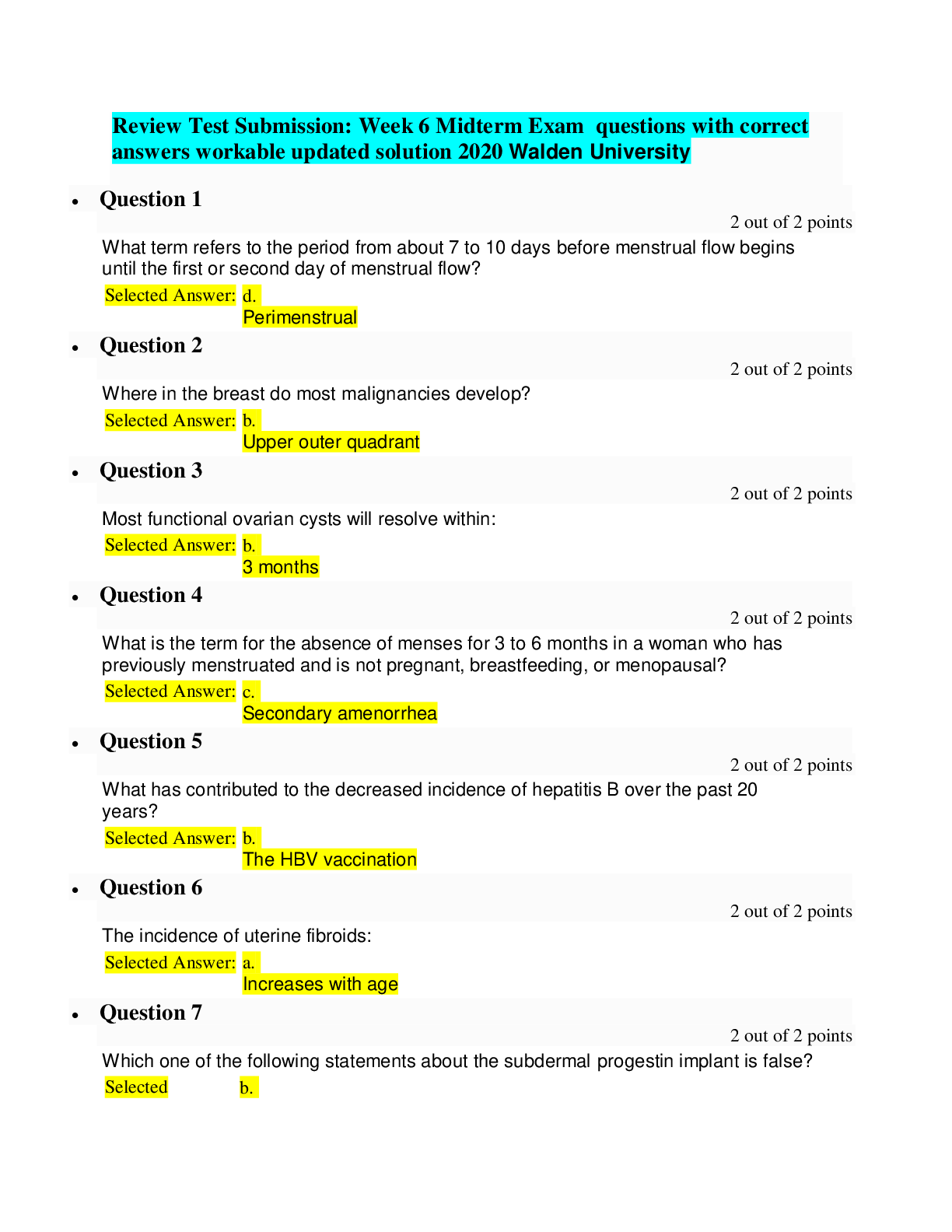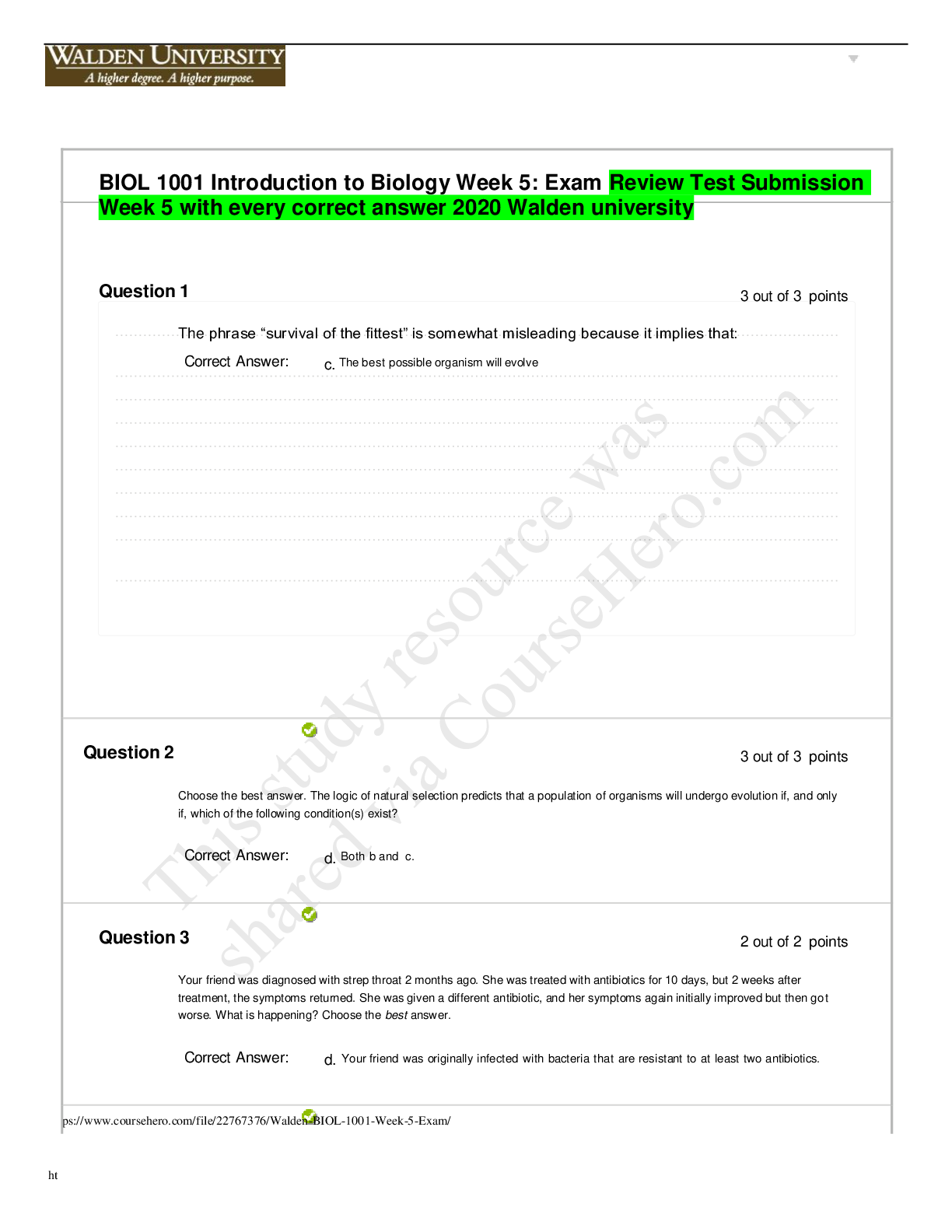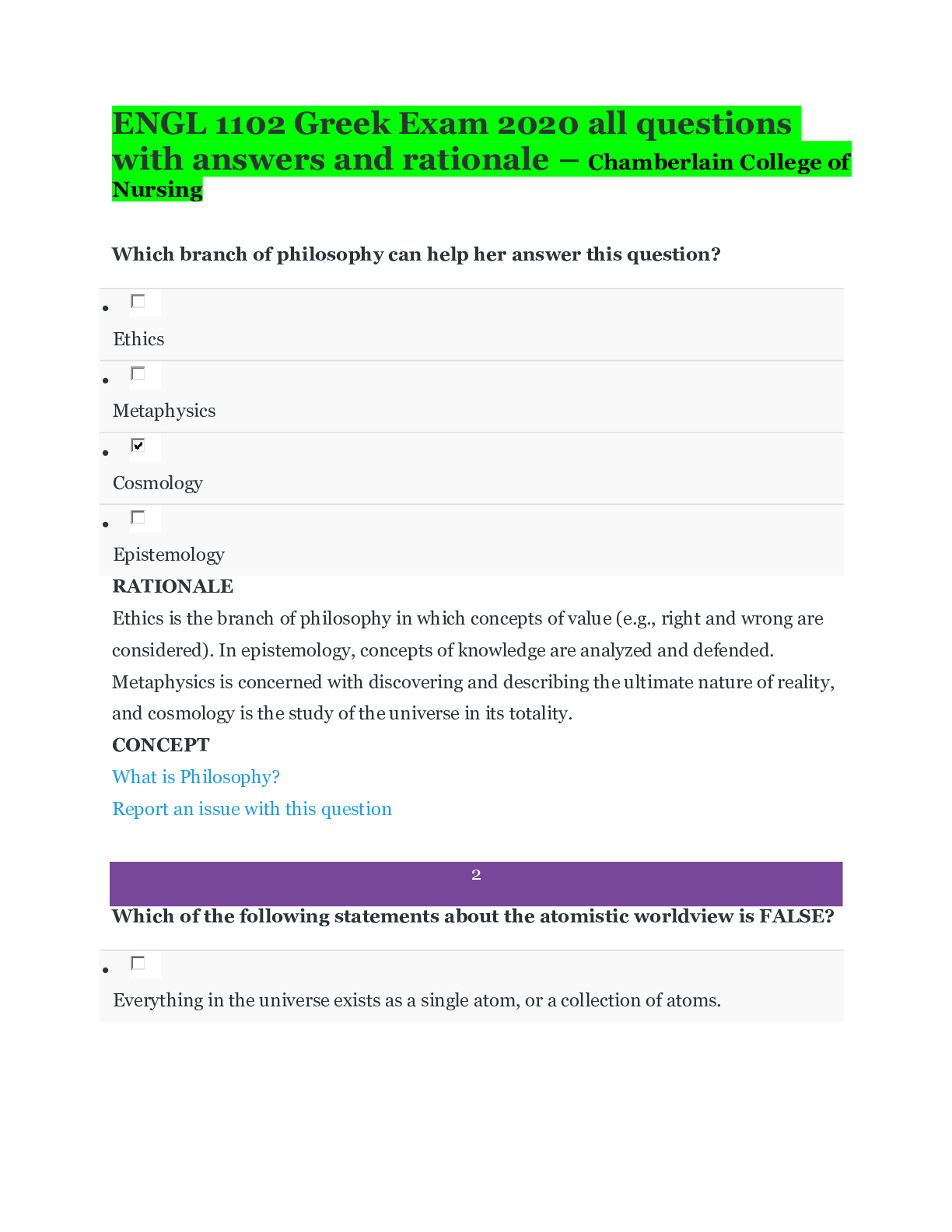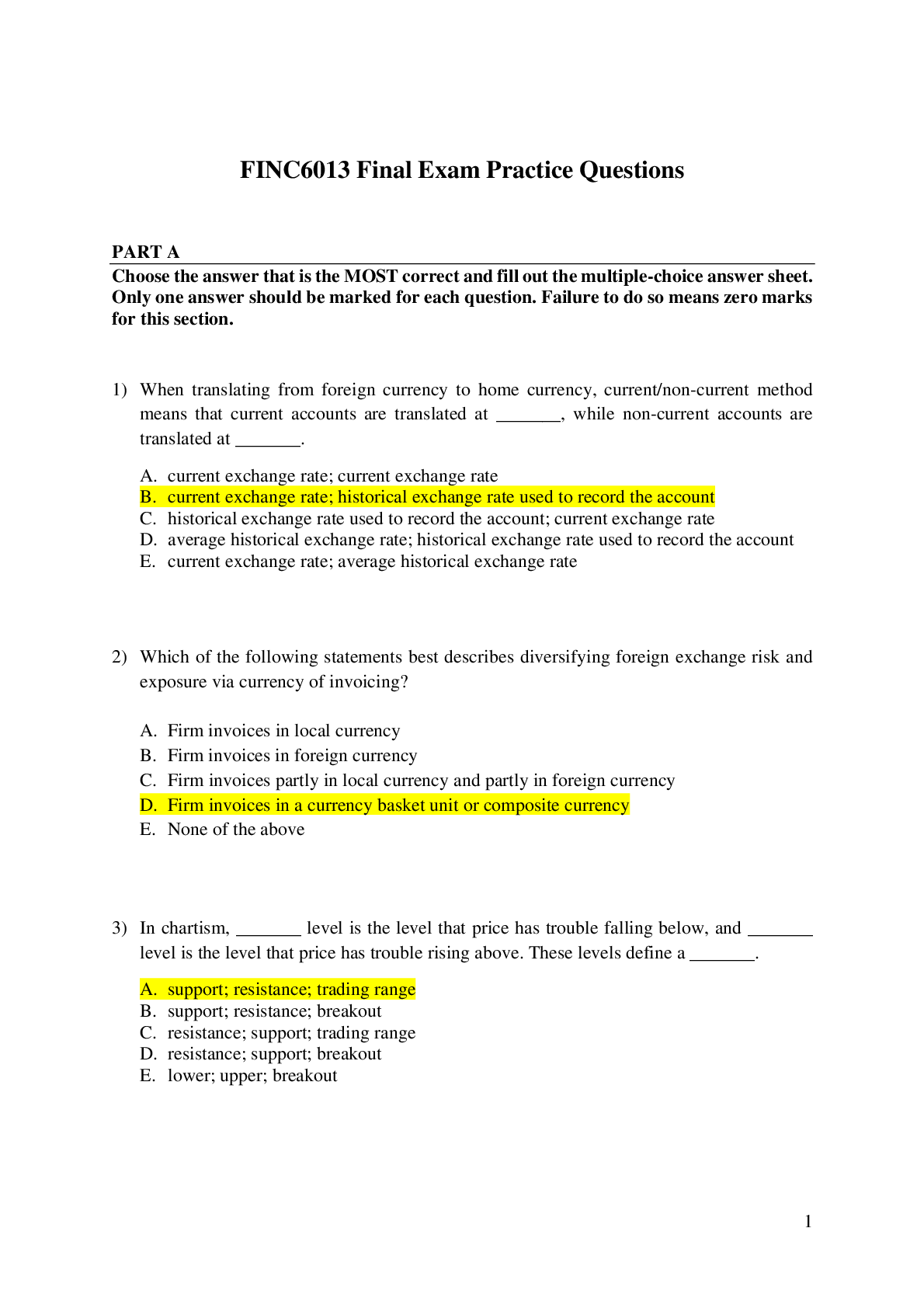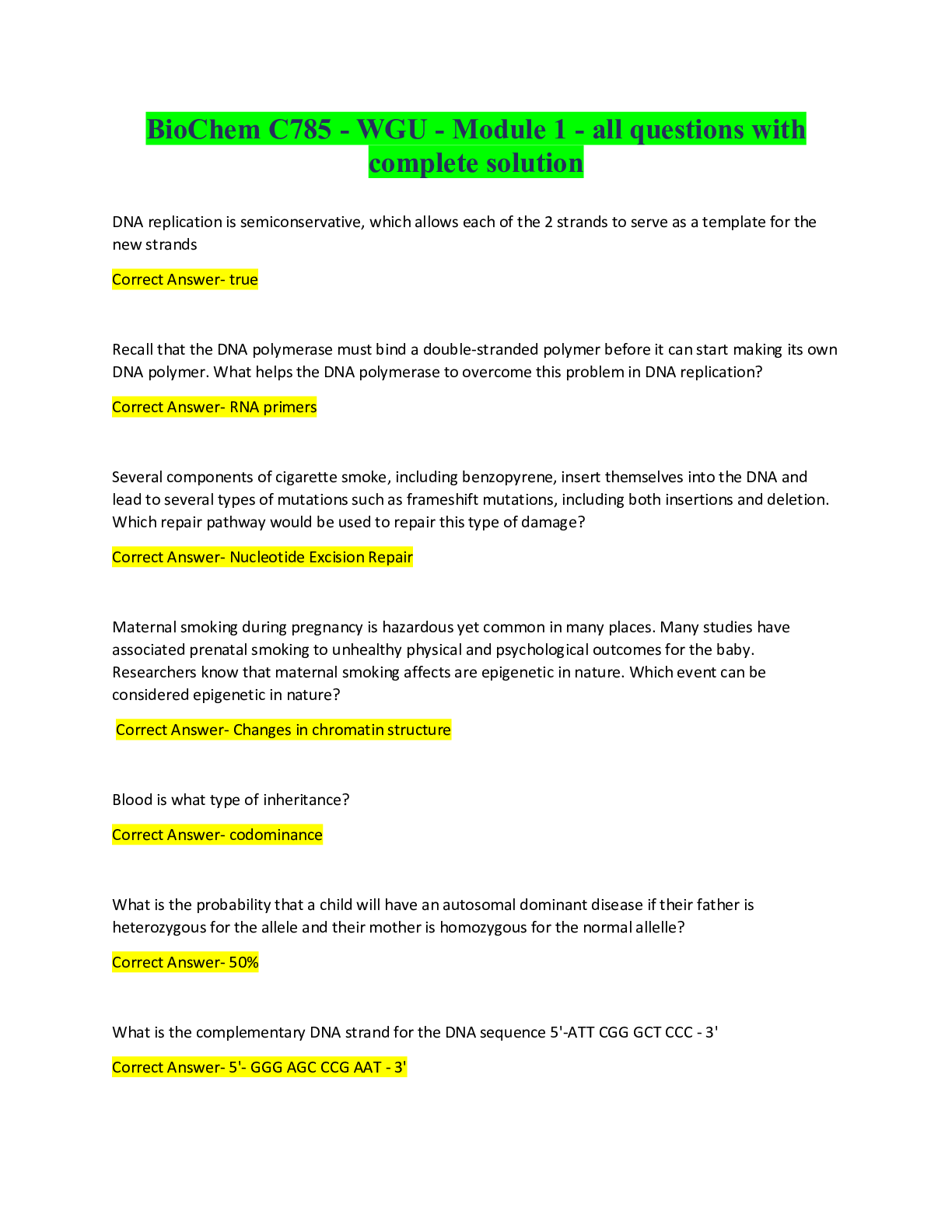*NURSING > QUESTIONS & ANSWERS > NURSING 697 quiz test latest working solution containing all questions with 100% answers (august 202 (All)
NURSING 697 quiz test latest working solution containing all questions with 100% answers (august 2020 walden university )
Document Content and Description Below
NURSING 697 quiz test latest working solution containing all questions with 100% answers (august 2020 walden university ) Question 1 3 / 3 pts A 40 year old man without a significant past medical... history is seen in the emergency room with a 3-day history of fever and shaking chills, productive cough, anorexia and the development of right-sided pleuritic chest pain with shortness of breath over the past 12 hours. A chest xray reveals a consolidated right middle lobe infiltrate. Which of the following is the BEST management strategy? Correct! Question 2 3 / 3 pts J.K. is a 23 year old male presenting for follow-up of his asthma. Which of the following indicate that J.K.'s symptoms are not controlled: Check all the answers that apply. Question 3 0 / 3 pts According to the Berlin Definition, all of the following are needed to diagnose Acute Respiratory Distress Syndrome (ARDS) EXCEPT: Question 4 3 / 3 pts A 90 year old male is admitted to the hospital from a nursing home. On exam you discover a partial thickness, 2 inch diameter area of breakdown. It is located 1 inch to the right of the sacrum. There is no tunneling. The wound is red, clean, and there is no drainage or slough present. What stage is this ulcer? Correct! Question 5 3 / 3 pts Mr. S is a 67 year old with COPD (FEV1 = 55%). He quit smoking 10 years ago. He has just complete pulmonary rehab. He had the influenza vaccine and the pneumococcal vaccine this year. He uses his short acting B-agonist (albuterol) on a regular basis and still reports being symptomatic. According to the Stepwise approach discussed in the lecture, the next best treatment option for Mr. S is: Question 6 3 / 3 pts Mr. M was admitted yesterday for workup of abdominal pain and was found to have acute choleycystitis. He is going to the OR early tomorrow morning. He is currently NPO. He has no drains. He weighs 92 kg. Based on his weight, you calculate your maintenance IV fluid rate to be approximately: Correct! Question 7 3 / 3 pts KC is a 40 year old female presenting to the ED after a penetrating knife injury to the chest. On presentation her heart rate is 110 and regular, respiratory rate 34, and blood pressure 80/50. She has decreased breath sounds bilaterally. Her right lung is tympanic to percussion. Her trachea is shifted to the left. The BEST next step in management is: Question 8 3 / 3 pts Which pulmonary function test value would you expect to be reduced in a patient with restrictive lung disease? Question 9 3 / 3 pts Which of the following markers best indicate the progression of PAH? Correct! Question 10 3 / 3 pts Causes of aortic aneurysms include all of the following EXCEPT: Question 11 3 / 3 pts ML, a 74 year old male, vomited as he was emergently intubated several days ago. You now suspect he has an aspiration pneumonia. The BEST antibiotic choice for this patient is: Question 12 3 / 3 pts Administering an anemic patient one unit of packed red blood cells (PRBCs) for a low hemoglobin should yield the following response: Question 13 0 / 3 pts Risk factors for Acute Respiratory Distress Syndrome (ARDS) including all of the following EXCEPT: Question 14 3 / 3 pts Asthma is characterized by: Question 15 3 / 3 pts A 22 y/o male who after a few days of sinus congestion comes to the ER with a fever, severe headache and neck stiffness. Lumbar puncture results show increased WBCs in the cerebrospinal fluid. Based on the patient presentation and LP results which is your best treatment option? Question 16 3 / 3 pts Aggressive fluid resuscitation with normal saline can potentially cause Question 17 3 / 3 pts You are paged by an RN that your patient received FFP 2 hours ago. She informs you the patient now has a temperature of 101.0, and has new onset dyspnea with an Sa02 of 88% on 2 liters nasal cannula. His blood pressure is 89/64 (BP was 120/72 prior to starting the FFP). The most likely cause of these symptoms is Question 18 3 / 3 pts JH is a 21 year old male who was the driver in a high speed motor vehicle collision. His car struck a telephone pole while traveling 65 mph. On arrival to the trauma bay his HR=110, BP 112/84, RR 18. He is quickly intubated and a chest xray shows a widened mediastinum. You are concerned he may have sustained an aortic injury. What study will you order to help confirm the diagnosis of aortic injury? Question 19 3 / 3 pts Cellulitis is MOST likely due to the following type of bacteria: Question 20 3 / 3 pts Mrs. T is a 70 year old female who presents to the ED with a history of CAD, s/p CABG five years ago. She arrives with complaints of feeling "winded". She appears short of breath, her vital signs are: temp 100.9, RR 32, HR 104, BP 88/60. SaO2 on room air is 91%. CXR shows a right middle lobe and right upper lobe infiltrate. The BEST plan for Mrs. T is: Question 21 3 / 3 pts Goals for managing a patient in hemorrhagic shock include all of the following EXCEPT: Correct! Question 22 3 / 3 pts In addition to targeted medical management, treatments for pulmonary arterial hypertension (PAH) can include all of the following EXCEPT: Correct! Question 23 3 / 3 pts The estimated needs of protein per day for the non-obese critically ill (non-burn) adult is: Correct! Question 24 3 / 3 pts Mr. M has been intubated in the ICU for five days with a severe chest wall injury following a motor vehicle collision. You would like to initiate feeding and are considering enteral versus parenteral nutrition. All of the following conditions are reasons to consider ordering parenteral nutrition EXCEPT: nutrition. Question 25 Original Score: 3 / 3 pts Regraded Score: 3 / 3 pts All of the following are expected findings on pulmonary function tests in a patient with COPD or an obstructive pattern- EXCEPT? Question 26 3 / 3 pts The systemic agent of choice for a MRSA infection is: Question 27 3 / 3 pts Which of the following is TRUE regarding prevention and management of moisture associated skin damage? Question 28 3 / 3 pts You are highly suspicious that your patient has pulmonary arterial hypertension (PAH). The gold standard diagnostic study needed to confirm the diagnosis is: Correct! Question 29 3 / 3 pts Which of the following drugs would be best for treatment of a moderate acute asthma attack? Question 30 3 / 3 pts Mrs.P is a 50 year old female brought to ER by Fire Rescue(FR) s/p high speed MVA (motor vehicle accident). Per FR report the car had no air bag, the patient was an unrestrained driver who sustained an apparent forceful blunt trauma to chest by the steering wheel. A preliminary CT chest report reveals injuries consistent with a significant pulmonary contusion. She is stabilized in the ER, intubated & then transferred to ICU. You now have Mrs. P stabilized on appropriate ventilator settings. You complete her admission to ICU assessment and notice: HR= 112; BP = 96/ 50; heart sounds are muffled & neck veins distended. Based on these clinical findings you are MOST concerned about: Question 31 3 / 3 pts The treatment option for ARDS with the BEST evidence for associated decreased mortality is: Question 32 3 / 3 pts Which of the following is the BEST anti-hypertensive agent for a patient with an ascending thoracic aortic aneurysm? Question 33 3 / 3 pts A 75 year old female s/p CVA now has Stage III pressure ulcer over her sacrum. 75% of wound is filled with yellow, stringy slough. The area surrounding the wound is intact. Patient is afebrile. Which initial intervention would be most appropriate? Question 1 3 / 3 pts A 40 year old man without a significant past medical history is seen in the emergency room with a 3-day history of fever and shaking chills, productive cough, anorexia and the development of right-sided pleuritic chest pain with shortness of breath over the past 12 hours. A chest xray reveals a consolidated right middle lobe infiltrate. Which of the following is the BEST management strategy? Correct! Question 2 3 / 3 pts J.K. is a 23 year old male presenting for follow-up of his asthma. Which of the following indicate that J.K.'s symptoms are not controlled: Check all the answers that apply. Question 3 0 / 3 pts According to the Berlin Definition, all of the following are needed to diagnose Acute Respiratory Distress Syndrome (ARDS) EXCEPT: Question 4 3 / 3 pts A 90 year old male is admitted to the hospital from a nursing home. On exam you discover a partial thickness, 2 inch diameter area of breakdown. It is located 1 inch to the right of the sacrum. There is no tunneling. The wound is red, clean, and there is no drainage or slough present. What stage is this ulcer? Correct! Question 5 3 / 3 pts Mr. S is a 67 year old with COPD (FEV1 = 55%). He quit smoking 10 years ago. He has just complete pulmonary rehab. He had the influenza vaccine and the pneumococcal vaccine this year. He uses his short acting B-agonist (albuterol) on a regular basis and still reports being symptomatic. According to the Stepwise approach discussed in the lecture, the next best treatment option for Mr. S is: Question 6 3 / 3 pts Mr. M was admitted yesterday for workup of abdominal pain and was found to have acute choleycystitis. He is going to the OR early tomorrow morning. He is currently NPO. He has no drains. He weighs 92 kg. Based on his weight, you calculate your maintenance IV fluid rate to be approximately: Correct! Question 7 3 / 3 pts KC is a 40 year old female presenting to the ED after a penetrating knife injury to the chest. On presentation her heart rate is 110 and regular, respiratory rate 34, and blood pressure 80/50. She has decreased breath sounds bilaterally. Her right lung is tympanic to percussion. Her trachea is shifted to the left. The BEST next step in management is: Question 8 3 / 3 pts Which pulmonary function test value would you expect to be reduced in a patient with restrictive lung disease? Question 9 3 / 3 pts Which of the following markers best indicate the progression of PAH? Correct! Question 10 3 / 3 pts Causes of aortic aneurysms include all of the following EXCEPT: Question 11 3 / 3 pts ML, a 74 year old male, vomited as he was emergently intubated several days ago. You now suspect he has an aspiration pneumonia. The BEST antibiotic choice for this patient is: Question 12 3 / 3 pts Administering an anemic patient one unit of packed red blood cells (PRBCs) for a low hemoglobin should yield the following response: Question 13 0 / 3 pts Risk factors for Acute Respiratory Distress Syndrome (ARDS) including all of the following EXCEPT: Question 14 3 / 3 pts Asthma is characterized by: Question 15 3 / 3 pts A 22 y/o male who after a few days of sinus congestion comes to the ER with a fever, severe headache and neck stiffness. Lumbar puncture results show increased WBCs in the cerebrospinal fluid. Based on the patient presentation and LP results which is your best treatment option? Question 16 3 / 3 pts Aggressive fluid resuscitation with normal saline can potentially cause Question 17 3 / 3 pts You are paged by an RN that your patient received FFP 2 hours ago. She informs you the patient now has a temperature of 101.0, and has new onset dyspnea with an Sa02 of 88% on 2 liters nasal cannula. His blood pressure is 89/64 (BP was 120/72 prior to starting the FFP). The most likely cause of these symptoms is . Question 18 3 / 3 pts JH is a 21 year old male who was the driver in a high speed motor vehicle collision. His car struck a telephone pole while traveling 65 mph. On arrival to the trauma bay his HR=110, BP 112/84, RR 18. He is quickly intubated and a chest xray shows a widened mediastinum. You are concerned he may have sustained an aortic injury. What study will you order to help confirm the diagnosis of aortic injury? Question 19 3 / 3 pts Cellulitis is MOST likely due to the following type of bacteria: Question 20 3 / 3 pts Mrs. T is a 70 year old female who presents to the ED with a history of CAD, s/p CABG five years ago. She arrives with complaints of feeling "winded". She appears short of breath, her vital signs are: temp 100.9, RR 32, HR 104, BP 88/60. SaO2 on room air is 91%. CXR shows a right middle lobe and right upper lobe infiltrate. The BEST plan for Mrs. T is: Question 21 3 / 3 pts Goals for managing a patient in hemorrhagic shock include all of the following EXCEPT: Question 22 3 / 3 pts In addition to targeted medical management, treatments for pulmonary arterial hypertension (PAH) can include all of the following EXCEPT: Correct! . Question 23 3 / 3 pts The estimated needs of protein per day for the non-obese critically ill (non-burn) adult is: Correct! Question 24 3 / 3 pts Mr. M has been intubated in the ICU for five days with a severe chest wall injury following a motor vehicle collision. You would like to initiate feeding and are considering enteral versus parenteral nutrition. All of the following conditions are reasons to consider ordering parenteral nutrition EXCEPT: nutrition. Question 25 Original Score: 3 / 3 pts Regraded Score: 3 / 3 pts All of the following are expected findings on pulmonary function tests in a patient with COPD or an obstructive pattern- EXCEPT? Question 26 3 / 3 pts The systemic agent of choice for a MRSA infection is: Question 27 3 / 3 pts Which of the following is TRUE regarding prevention and management of moisture associated skin damage? Question 28 3 / 3 pts You are highly suspicious that your patient has pulmonary arterial hypertension (PAH). The gold standard diagnostic study needed to confirm the diagnosis is: Correct! Question 29 3 / 3 pts Which of the following drugs would be best for treatment of a moderate acute asthma attack? Question 30 3 / 3 pts Mrs.P is a 50 year old female brought to ER by Fire Rescue(FR) s/p high speed MVA (motor vehicle accident). Per FR report the car had no air bag, the patient was an unrestrained driver who sustained an apparent forceful blunt trauma to chest by the steering wheel. A preliminary CT chest report reveals injuries consistent with a significant pulmonary contusion. She is stabilized in the ER, intubated & then transferred to ICU. You now have Mrs. P stabilized on appropriate ventilator settings. You complete her admission to ICU assessment and notice: HR= 112; BP = 96/ 50; heart sounds are muffled & neck veins distended. Based on these clinical findings you are MOST concerned about: Question 31 3 / 3 pts The treatment option for ARDS with the BEST evidence for associated decreased mortality is: Correct! Question 32 3 / 3 pts Which of the following is the BEST anti-hypertensive agent for a patient with an ascending thoracic aortic aneurysm? Question 33 3 / 3 pts A 75 year old female s/p CVA now has Stage III pressure ulcer over her sacrum. 75% of wound is filled with yellow, stringy slough. The area surrounding the wound is intact. Patient is afebrile. Which initial intervention would be most appropriate? ================================================================ Question 1 2.5 / 2.5 pts Mr. M has been intubated in the ICU for five days with a severe chest wall injury following a motor vehicle collision. You would like to initiate feeding and are considering enteral versus parenteral nutrition. All of the following conditions are reasons to consider ordering parenteral nutrition EXCEPT: Question 2 2.5 / 2.5 pts You are the NP in the emergency department and ordered a Chest CT on a 69 year old male who presented with sudden pain between his shoulder blades. He has a history of hypertension and smoking. The CT report reads: "...an intimal tear of the aorta in the posterior mediastinum at approximately the level of the 4th-8th thoracic vertebrae...." . Based upon this CT report you are MOST concerned for: Question 3 2.5 / 2.5 pts Asthma is characterized by: PartialQuestion 4 1.67 / 2.5 pts Which of the following statements are TRUE regarding Chronic Obstructive Pulmonary Disease (COPD)? CHOOSE ALL THAT APPLY IncorrectQuestion 5 0 / 2.5 pts All of the following findings on Pulmonary Function Tests (PFTs) are most consistent with an obstructive pattern EXCEPT: Question 6 2.5 / 2.5 pts Please identify first line treatment options for a patient with an acute Asthma exacerbation. Please mark ALL that apply: PartialQuestion 7 0.63 / 2.5 pts Your are concerned your recently extubated patient may be at risk for aspiration. Which of the following symptoms warrant a swallow evaluation? Select All that apply Question 8 2.5 / 2.5 pts A 70 yr old male presents for preoperative evaluation of bilateral knee replacement. He has a history of COPD. What PFT shows the severity of his disease? Question 9 2.5 / 2.5 pts Mr. S is a 67 year old with COPD (FEV1 = 55%). He quit smoking 10 years ago. He has just complete pulmonary rehab. He had the influenza vaccine and the pneumococcal vaccine this year. He uses his short acting B-agonist (albuterol) on a regular basis and still reports being symptomatic. According to the Stepwise approach discussed in the lecture, the next best treatment option for Mr. S is: . IncorrectQuestion 10 0 / 2.5 pts MN is a 70 year old female who has a 30 pack-year smoking history, hypertension and hyperlipidemia. She has a family history of "some kind of aneurysm". She presents with hoarseness that started about 2 months ago and has gotten worse over the past two months. She is also complaining that she has difficulty swallowing solid foods. Based upon her history and presentation you are concerned she may have a(n): Question 11 2.5 / 2.5 pts Treatment for severe COPD exacerbation include all of the following EXCEPT: PartialQuestion 12 1.88 / 2.5 pts Please match each Pulmonary Function Test (PFT) measure with the BEST description. Question 13 2.5 / 2.5 pts The estimated needs of protein per day for the non-obese critically ill (non-burn) adult is: Question 14 2.5 / 2.5 pts J.K. is a 23 year old male presenting for follow-up of his asthma. Which of the following indicate that J.K.'s symptoms are not controlled: Check all that apply. Question 15 2.5 / 2.5 pts Match the diabetes medications/classes with the appropriate description Question 16 2.5 / 2.5 pts Physical exam findings of volume overload in heart failure include all of the following EXCEPT: UnansweredQuestion 17 0 / 2.5 pts An 85 year old male with a history of heart failure presents to your office for a routine visit. he reports he's been short of breath for the last 5 days when walking from one room to the next. His weight is up 15 pounds from his last visit three months ago and he reports bilateral foot and ankle edema. He is taking furosemide 40 mg BID, potassium 40 mEq daily, carvedilol 3.125 mg BID, and lisinopril 5 mg daily. His heart rate is 110 beats per minute, blood pressure 95/60, oxygen saturation 89%. Your BEST treatment option is: UnansweredQuestion 18 0 / 2.5 pts A patient with a history of heart failure with reduced ejection fraction (HFrEF) is transferred to your coronary care unit after becoming increasingly short of breath on the surgical floor. His ECG demonstrates no ischemia. He has normal renal function. His lung exam reveals rales and his weight is up 10 pounds since admission. He reports he feels "short of breath and dizzy". He was given 40 mg IV lasix 30 minutes ago and his current blood pressure is 80/60, respiratory rate is 40, heart rate is 112 beats per minute. Your best intervention at this time is: UnansweredQuestion 19 0 / 2.5 pts The most common cause of heart failure is: UnansweredQuestion 20 0 / 2.5 pts HK is a 50 year old male with a 40 pack year smoking history. He presents to the vascular surgery clinic with complaints of pain in his left lower calf. This pain is present whenever he walks more than half a block, and is relieved with rest. Based solely on his complaints, you would most likely expect to find occlusion at what level? Question 21 2.5 / 2.5 pts MR L is a 48 year old male who reported pain in his right thigh and calf at his last PCP appointment. Pain is worse with ambulation, especially when he walks more than 1 block. It is improved when he rests. His PCP ordered Pulse Volume Recordings which show calcification and arterial occlusive disease in his common and superficial femoral artery. As the ACNP on the vascular service, in addition to starting aspirin and plavix you recommend: IncorrectQuestion 22 0 / 2.5 pts You are an NP evaluating a patient in a vascular surgery practice. The patient describes constant burning pain in her right distal leg and foot, most severe at night. The pain "eases up" a bit when she dangles her leg over the edge of the bed. The description of this pain most closely describes the symptoms of: Question 23 2.5 / 2.5 pts If a patient had an ankle-brachial index of 1.2 you would expect them to have: IncorrectQuestion 24 0 / 2.5 pts Which of the following patients is the BEST candidate for TAVR (transcatheter aortic valve replacement) procedure? Question 25 2.5 / 2.5 pts An 84 year old woman with a history of rheumatic heart disease is in the hospital for treatment of new onset atrial fibrillation with a rapid ventricular heart rate. On cardiac auscultation you hear a diastolic murmur, decrescendo in nature, with pre-systolic attenuation and an opening snap heard best at the apex of the heart. Which of the following is the most likely etiology of this murmur? IncorrectQuestion 26 0 / 2.5 pts The most common etiology of valvular heart disease in a 45 year old male in a Western country is: Question 27 2.5 / 2.5 pts In which of the following patients is exercise testing discouraged? Question 28 2.5 / 2.5 pts A 72 year old patient is in the hospital recovering from an aneurysm repair. He has a history of diabetes and normally takes 20 units of lantus and 5 units of aspart with meals at home. His home medications were ordered post-op now that he is eating, and his glucose has been in the 110-150 range. It is day 4 of his hospitalization and today his creatinine has increased from his baseline 1.0 to 2.1. As the ACNP you recognize that he will need: Question 29 2.5 / 2.5 pts Match the diabetes medications/classes with the appropriate description Question 30 2.5 / 2.5 pts A 21-year-old type I diabetic discontinues her insulin pump because it’s not fashionable. Which of the following is the most likely complication to develop? Question 31 2.5 / 2.5 pts Your patient who has no known history of diabetes requires a gastric tube for feeding. He has just started bolus tube feeds and his blood sugars are now in the 200's. The best insulin for this patient is: Question 32 2.5 / 2.5 pts A 90 year old male is admitted to the hospital from a nursing home. On exam you discover a partial thickness, 2 inch diameter area of breakdown. It is located 1 inch to the right of the sacrum. There is no tunneling. The wound is red, clean, and there is no drainage or slough present. What stage is this ulcer? Question 33 2.5 / 2.5 pts You are called to the bedside by an RN to assess a wound. The patient's family is at the bedside and they are concerned the wound needs debridement. You explain that not all wounds need sharp debridement, but the wound that most likely indicates the need for sharp debridement is: Question 34 2.5 / 2.5 pts Match each wound with the BEST treatment for the underlying etiology: Question 35 2.5 / 2.5 pts Mr. W is a 74 year old diabetic who is admitted for a community acquired pneumonia. He has a past history of: DM, PVD, & mild dementia. He lives with his son who works a great deal. During your admission assessment you note a wound near the posterior aspect of his right heel. Which of the following characteristics support this likely being a diabetic ulcer: Question 36 2.5 / 2.5 pts Mr. K is a 55 year old morbidly obese man who is intubated for ARDS. He is hemodynamically stable, as is volume recussitated. The nurses ask what the plan for nutrition is. Based on the Nutrition lecture you would: Question 37 2.5 / 2.5 pts What is the diagnostic "Gold Standard" for an aortic aneurysm? Question 38 2.5 / 2.5 pts Which of the following is the first line anti-hypertensive agent for a patient with thoracicaortic disease? Question 39 2.5 / 2.5 pts Which of the following drugs would be best for treatment of a moderate acute asthma attack? Question 40 2.5 / 2.5 pts A 60-year-old male has had a chronic cough for over 5 years with clear sputum production. He has smoked one pack of cigarettes per day for 20 years and continues to do so. X-ray of the chest shows hyperinflation without infiltrates. Arterial blood gases show a pH of 7.38, PCO2 of 40 mmHg, and PO2 of 65 mmHg. Spirometry shows an FEV1/FVC of 65%. Which of the following is the most important treatment modality for this patient? [Show More]
Last updated: 1 year ago
Preview 1 out of 49 pages
Instant download

Buy this document to get the full access instantly
Instant Download Access after purchase
Add to cartInstant download
Reviews( 0 )
Document information
Connected school, study & course
About the document
Uploaded On
Aug 03, 2020
Number of pages
49
Written in
Additional information
This document has been written for:
Uploaded
Aug 03, 2020
Downloads
0
Views
46




